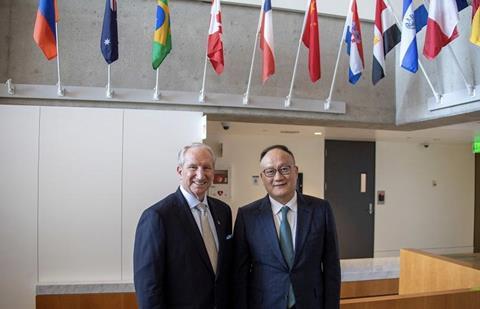New agreement focuses on creating more sustainable shipping routes and promoting supply chain digitisation

Officials at the Port of Los Angeles and Port of Guangzhou, China have signed a Memorandum of Understanding to further their relationship and cooperation.
Areas of collaboration include development of digital supply chain infrastructure, creation of a Trans-pacific Green Shipping Corridor between the two ports, and other sustainability initiatives to reduce port-related emissions and greenhouse gases.
“We are grateful to the Port of Guangzhou for their commitment to work with us on these important maritime initiatives,” said Port of LA executive director Gene Seroka. “The agreement signed today further reinforces our long-term relationship and like-minded pursuit of excellence in all aspects of port operations and signifies an important step toward decarbonising the supply chain.”
Xiuqing Sun, director general of the Guangzhou Port Authority, commented: “We have long valued our relationship with the Port of Los Angeles, and welcome this opportunity to build upon our bilateral cooperation.
“By continuing to share best practices and information, our ports will be better positioned to improve operational efficiencies and reduce harmful emissions related to those operations”.
The MOU represents continued cooperation between the ports of Los Angeles and Guangzhou, a relationship that dates back nearly four decades when the two ports signed their first ‘Friendship Port’ agreement in 1984.
The latest three-year MOU calls for best practice consultations and exchanging of ideas on supply chain efficiency and digital technology, and the sharing of lessons learned from the Port Optimizer, the digital community system developed by the Port of Los Angeles and in use since 2017.
The two ports also agreed to begin work to establish a Green Shipping Corridor, an initiative focused on reducing emissions along their respective trade routes and promoting low- and zero-carbon ships and fuels.
The Port of Los Angeles has already established Green Shipping Corridor partnerships with the Port of Singapore, Port of Shanghai, and the Japanese ports of Nagoya, Yokohama and Tokyo.
Other environmental initiatives in the agreement include cooperation on testing and deployment of zero-emission vehicles, cargo handling equipment and vessels, as well as exploration of energy use and alternative energy sources, among other items.
The Port of Los Angeles is the busiest seaport in the Western Hemisphere, ranking as the No. 1 container port in the US for 23 consecutive years. In 2022, it facilitated US$311bn in trade and handled a total of 9.9m TEUs, the second busiest calendar year in the port’s 116-year history.



